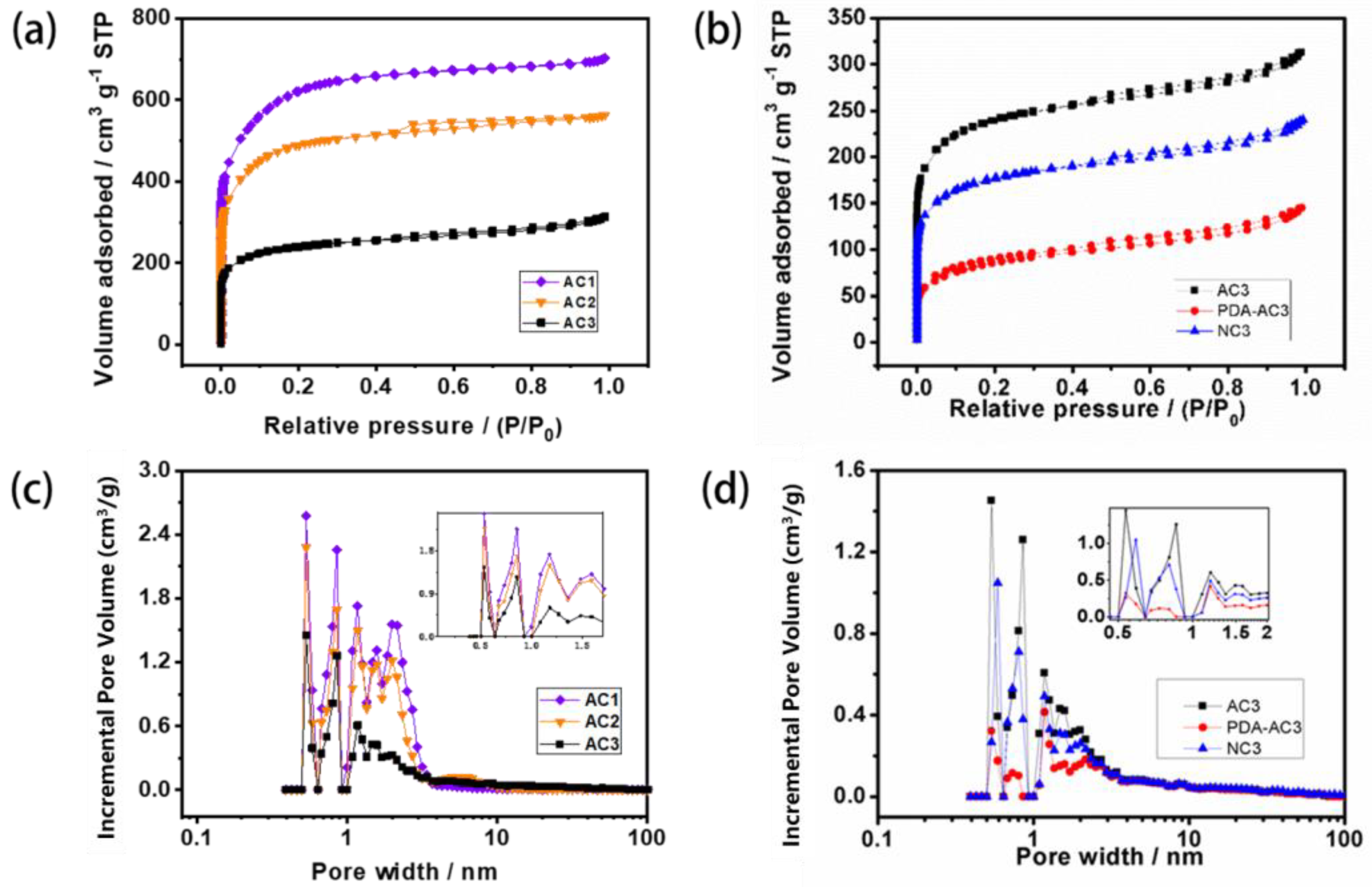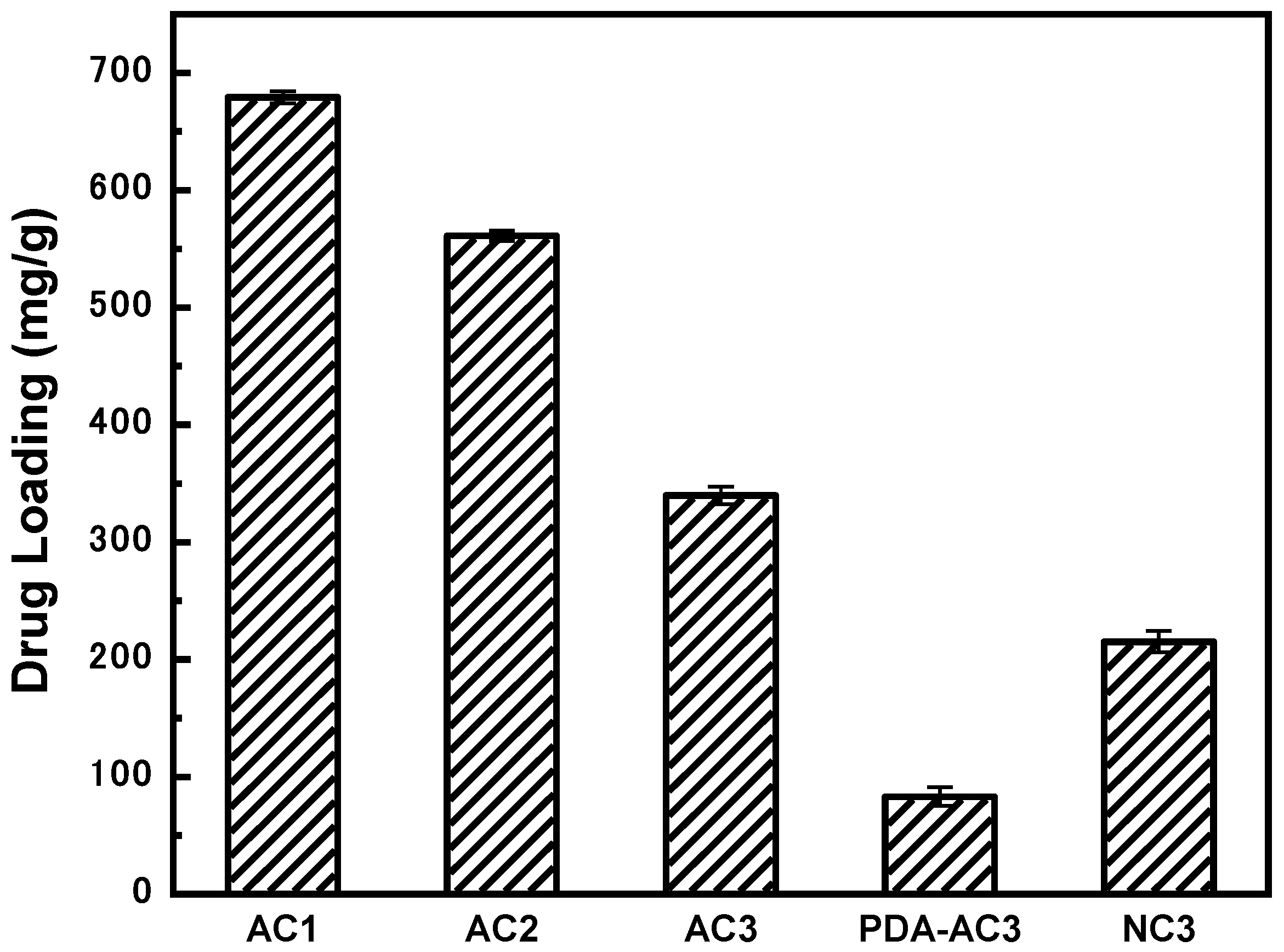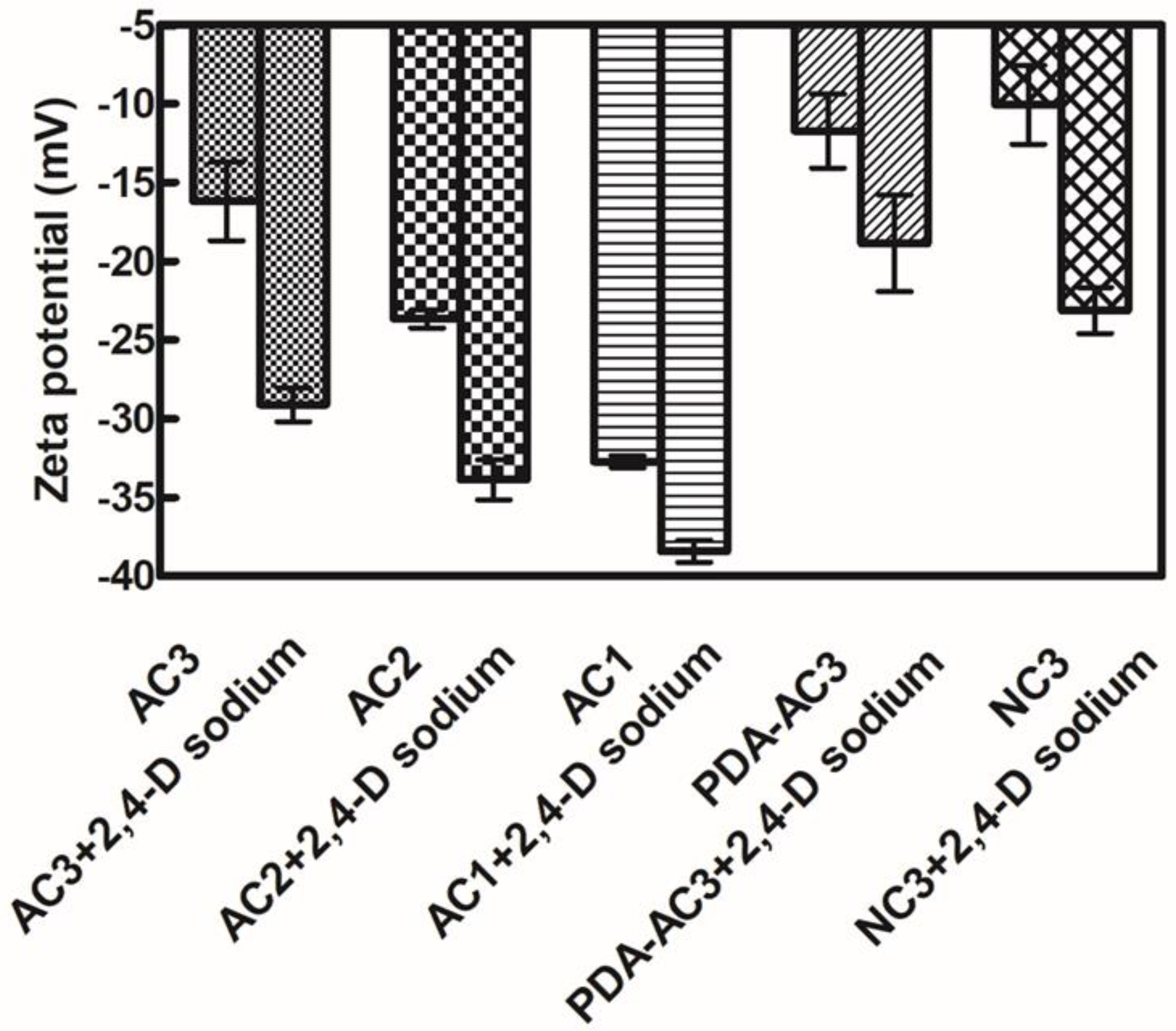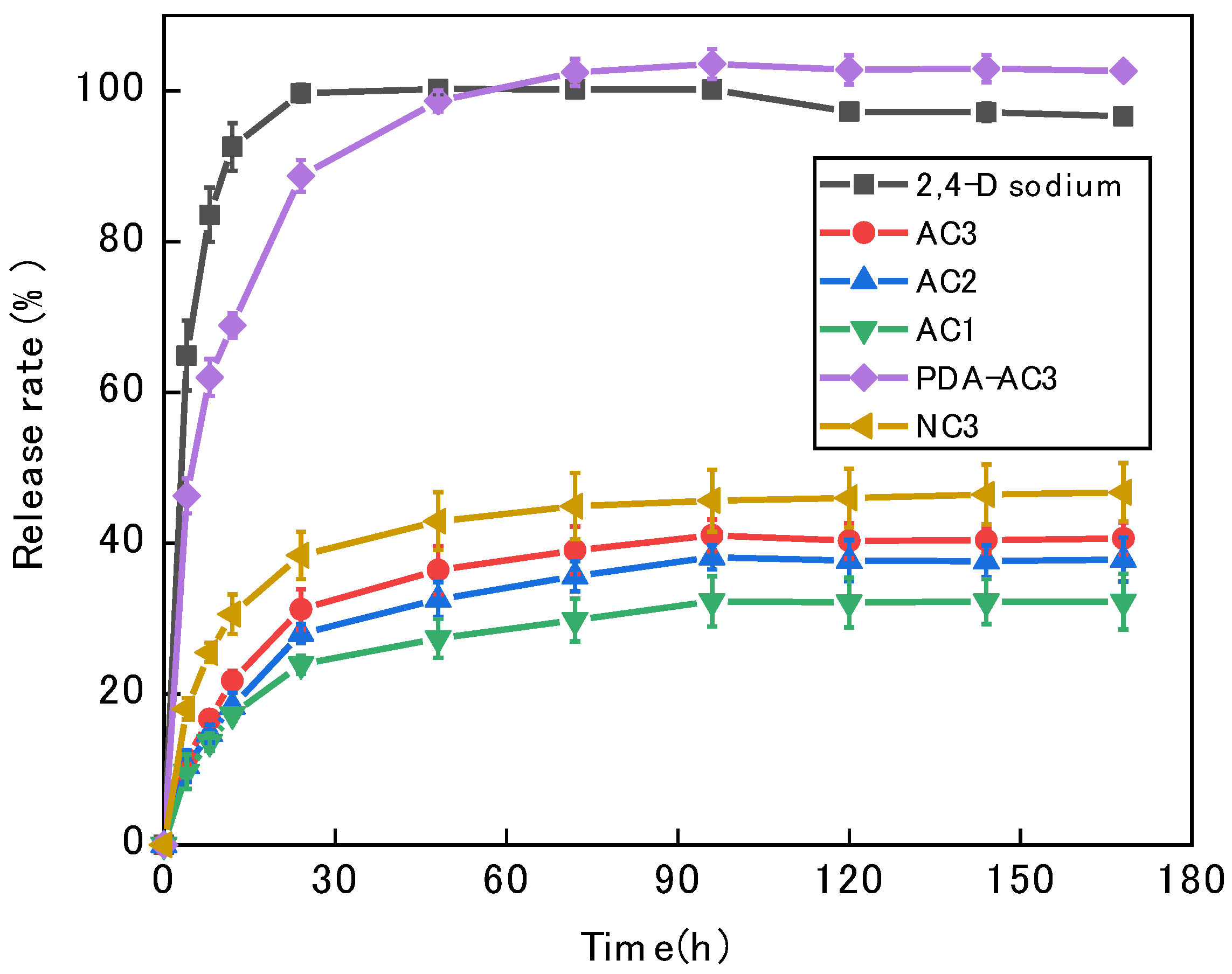The Enhanced and Tunable Sustained Release of Pesticides Using Activated Carbon as a Carrier
Abstract
1. Introduction
2. Material and Methods
2.1. Materials
2.2. Loading of 2,4-D Sodium into the AC
2.3. Modification of AC3 with Dopamine Hydrochloride
2.4. Preparation of Nitrogen-Doped Activated Carbon NC3
2.5. Characterization
2.5.1. Scanning Electron Microscope (SEM)
2.5.2. Nitrogen Adsorption Measurements
2.5.3. Zeta Potential
2.6. Release of 2,4-D Sodium
3. Results and Discussion
3.1. Structure of the Five ACs
3.2. The Modification of AC3
3.3. Adsorptive Property of 2,4-D Sodium into ACs
3.4. The Zeta Potential Analysis
3.5. The Release of 2,4-D Sodium
4. Conclusions
Author Contributions
Funding
Acknowledgments
Conflicts of Interest
References
- Mogul, M.G.; Akin, H.; Hasirci, N.; Trantolo, D.J.; Gresser, J.D.; Wise, D.L. Controlled release of biologically active agents for purposes of agricultural crop management. Resour. Conserv. Recycl. 1996, 16, 289–320. [Google Scholar] [CrossRef]
- Cao, Y.; Huang, L.; Chen, J.; Liang, J.; Long, S.; Lu, Y. Development of a controlled release formulation based on a starch matrix system. Int. J. Pharm. 2005, 298, 108–116. [Google Scholar] [CrossRef] [PubMed]
- Guan, H.; Chi, D.; Yu, J.; Li, H. Dynamics of residues from a novel nano-imidacloprid formulation in soyabean fields. Crop Prot. 2010, 29, 942–946. [Google Scholar] [CrossRef]
- Karimi, M.H.; Mahdavinia, G.R.; Massoumi, B. pH-controlled sunitinib anticancer release from magnetic chitosan nanoparticles crosslinked with kappa-carrageenan. Mater. Sci. Eng. C 2018, 91, 705–714. [Google Scholar] [CrossRef] [PubMed]
- Bakhtiary, S.; Shirvani, M.; Shariatmadari, H. Adsorption-desorption behavior of 2, 4-D on NCP-modified bentonite and zeolite, implications for slow-release herbicide formulations. Chemosphere 2013, 90, 699–705. [Google Scholar] [CrossRef] [PubMed]
- Flores-Céspedes, F.; Daza-Fernández, I.; Villafranca-Sánchez, M.; Fernández-Pérez, M.; Morillo, E.; Undabeytia, T. Lignin and ethylcellulose in controlled release formulations to reduce leaching of chloridazon and metribuzin in light-textured soils. J. Hazard. Mater. 2018, 343, 227–234. [Google Scholar] [CrossRef]
- Do, X.H.; Lee, B.K. Removal of Pb(2+) using a biochar-alginate capsule in aqueous solution and capsule regeneration. J. Environ. Manag. 2013, 131, 375–382. [Google Scholar] [CrossRef]
- Xiang, Y.; Zhang, G.; Chen, C.; Liu, B.; Cai, D.; Wu, Z. Fabrication of a pH-Responsively Controlled-Release Pesticide Using an Attapulgite-Based Hydrogel. ACS Sustain. Chem. Eng. 2018, 6, 1192–1201. [Google Scholar] [CrossRef]
- Xiang, Y.; Zhang, G.; Chi, Y.; Cai, D.; Wu, Z. Fabrication of a controllable nanopesticide system with magnetic collectability. Chem. Eng. J. 2017, 328, 320–330. [Google Scholar] [CrossRef]
- Kanampiu, F.; Karaya, H.; Burnet, M.; Gressel, J. Needs for and effectiveness of slow release herbicide seed treatment Striga control formulations for protection against early season crop phytotoxicity. Crop Prot. 2009, 28, 845–853. [Google Scholar] [CrossRef]
- Cork, A.; De Souza, K.; Hall, D.R.; Jones, O.T.; Casagrande, E.; Krishnaiah, K.; Syed, Z. Development of PVC-resin-controlled release formulation for pheromones and use in mating disruption of yellow rice stem borer, Scirpophaga incertulas. Crop Prot. 2008, 27, 248–255. [Google Scholar] [CrossRef]
- Bhatnagar, A.; Hogland, W.; Marques, M.; Sillanpää, M. An overview of the modification methods of activated carbon for its water treatment applications. Chem. Eng. J. 2013, 219, 499–511. [Google Scholar] [CrossRef]
- Dong, L.; Liu, W.; Jiang, R.; Wang, Z. Study on the adsorption mechanism of activated carbon removing low concentrations of heavy metals. Desalin. Water Treat. 2016, 57, 7812–7822. [Google Scholar] [CrossRef]
- Huang, Y.; Sun, Y.; Xu, Z.; Luo, M.; Zhu, C.; Li, L. Removal of aqueous oxalic acid by heterogeneous catalytic ozonation with MnOx/sewage sludge-derived activated carbon as catalysts. Sci. Total Environ. 2017, 575, 50–57. [Google Scholar] [CrossRef] [PubMed]
- Xu, Z.; Zhang, D.; Chen, W.; Li, Y.; Yuan, S. Nanoscale iron oxides loaded granular activated carbon (GAC-NSIO) for cadmium removal. Desalin. Water Treat. 2016, 57, 3559–3571. [Google Scholar] [CrossRef]
- Liu, X.; Lai, D.; Wang, Y. Performance of Pb(II) removal by an activated carbon supported nanoscale zero-valent iron composite at ultralow iron content. J. Hazard. Mater. 2019, 361, 37–48. [Google Scholar] [CrossRef]
- Singh, V.; Masabni, J.; Baumann, P.; Isakeit, T.; Matocha, M.; Provin, T.; Liu, R.; Carson, K.; Bagavathiannan, M. Activated charcoal reduces pasture herbicide injury in vegetable crops. Crop Prot. 2019, 117, 1–6. [Google Scholar] [CrossRef]
- Inagaki, M. Pores in carbon materials-importance of their control. New Carbon Mater. 2009, 24, 193–232. [Google Scholar] [CrossRef]
- Kah, M.; Sigmund, G.; Xiao, F.; Hofmann, T. Sorption of ionizable and ionic organic compounds to biochar, activated carbon and other carbonaceous materials. Water Res. 2017, 124, 673–692. [Google Scholar] [CrossRef]
- Miriyala, N.; Ouyang, D.; Perrie, Y.; Lowry, D.; Kirby, D.J. Activated carbon as a carrier for amorphous drug delivery, Effect of drug characteristics and carrier wettability. Eur. J. Pharm. Biopharm. 2017, 115, 197–205. [Google Scholar] [CrossRef]
- Burr, R.J.; Lee, W.O.; Appleby, A.P. Factors affecting use of activated carbon to improve herbicide selectivity. Weed Sci. 1972, 20, 180–183. [Google Scholar] [CrossRef]
- Pessenda, L.C.R.; Ledru, M.P.; Gouveia, S.M.; Aravena, R.; Ribeiro, A.S.; Bendashsollil, J.A.; Boulet, R. Holocene palaeoenvironmental reconstruction in norteastern Brazi inferred from polen, charcoal and carboon isotope records. Holocene 2005, 15, 812–820. [Google Scholar] [CrossRef]
- Rondon, M.A.; Lehmann, J.; Ramírez, J.; Hurtado, M. Biological nitrogen fixation by common beans (Phaseolus vulgaris L.) increases with bio-char additions. Biol. Fertil. Soils 2007, 43, 699–708. [Google Scholar] [CrossRef]
- Shamseldin, A.; El-Saadani, M.; Sadowsky, M.J.; An, C.S. Rapid identification and discrimination among Egyptian genotypes of Rhizobium leguminosarum bv. viciae and Sinorhizobium meliloti nodulating faba bean (Vicia faba L.) by analysis of nodC, ARDRA, and rDNA sequence analysis. Soil Biol. Biochem. 2009, 41, 45–53. [Google Scholar] [CrossRef]
- Uchimiya, M.; Klasson, K.T.; Wartelle, L.H.; Lima, I.M. Influence of soil properties on heavy metal sequestration by biochar amendment: 1. Copper sorption isotherms and the release of cations. Chemosphere 2011, 82, 1431–1437. [Google Scholar] [CrossRef] [PubMed]
- Uchimiya, M.; Klasson, K.T.; Wartelle, L.H.; Lima, I.M. Influence of soil properties on heavy metal sequestration by biochar amendment: 2. Copper desorption isotherms. Chemosphere 2011, 82, 1438–1447. [Google Scholar] [CrossRef]
- Chu, M.; Peng, J.; Zhao, J.; Liang, S.; Shao, Y.; Wu, Q. Laser light triggered-activated carbon nanosystem for cancer therapy. Biomaterials 2013, 34, 1820–1832. [Google Scholar] [CrossRef]
- Yokota, T.; Saito, T.; Narushima, Y.; Iwamoto, K.; Iizuka, M.; Hagiwara, A.; Sawai, K.; Kikuchi, S.; Kunii, Y.; Yamauchi, H. Lymph-node staining with activated carbon CH40, a new method for axillary lymph-node dissection in breast cancer. Can. J. Surg. 2000, 43, 191. [Google Scholar]
- Garrido-Herrera, F.J.; Gonzalez-Pradas, E.; Fernández-Pérez, M. Controlled release of isoproturon, imidacloprid, and cyromazine from alginate-bentonite-activated carbon formulations. J. Agric. Food Chem. 2006, 54, 10053–10060. [Google Scholar] [CrossRef]
- Guo, F.; Mao, X.; Wang, J.; Luo, F.; Wang, Z. Gemcitabine adsorbed onto carbon particles increases drug concentrations at the injection site and in the regional lymph nodes in an animal experiment and a clinical study. J. Int. Med. Res. 2011, 39, 2217–2227. [Google Scholar] [CrossRef]
- Lee, Y. Controlled release behavior of ph-responsive composite hydrogel containing activated carbon. Carbon Lett. 2009, 10, 33–37. [Google Scholar]
- Linares, C.F.; Palencia, A.; Goldwasser, M.R.; Rodríguez, K. Study of activated carbon modified with sodium carbonate as a possible antacid drug. Mater. Lett. 2006, 60, 439–441. [Google Scholar] [CrossRef]
- Linares, C.F.; Quintero, J.; Martínez, L.; González, G. A new antacid drug from activated carbon modified with calcium carbonate. Mater. Lett. 2007, 61, 2362–2364. [Google Scholar] [CrossRef]
- Ozkaya, B. Adsorption and desorption of phenol on activated carbon and a comparison of isotherm models. J. Hazard. Mater. 2006, 129, 158–163. [Google Scholar] [CrossRef]
- Garabrant, D.H.; Philbert, M.A. Review of 2, 4-dichlorophenoxyacetic acid (2, 4-D) epidemiology and toxicology. Crit. Rev. Toxicol. 2002, 32, 233–257. [Google Scholar] [CrossRef]
- Chao, Y.F.; Chen, P.C.; Wang, S.L. Adsorption of 2, 4-D on Mg/Al–NO3 layered double hydroxides with varying layer charge density. Appl. Clay Sci. 2008, 40, 193–200. [Google Scholar] [CrossRef]
- Cao, L.; Zhou, Z.; Niu, S.; Cao, C.; Li, X.; Shan, Y.; Huang, Q. Positive-charge functionalized mesoporous silica nanoparticles as nanocarriers for controlled 2,4-dichlorophenoxy acetic acid sodium salt release. J. Agric. Food Chem. 2018, 66, 6594–6603. [Google Scholar] [CrossRef]
- Lerro, C.C.; Beane reeman, L.E.; Portengen, L.; Kang, D.; Lee, K.; Blair, A.; Lynch, C.F.; Bakke, B.; De Roos, A.J.; Vermeulen, R.C. A longitudinal study of atrazine and 2, 4-D exposure and oxidative stress markers among iowa corn farmers. Environ. Mol. Mutagen. 2017, 58, 30–38. [Google Scholar] [CrossRef]
- Mountassif, D.; Kabine, M.; Mounchid, K.; Mounaji, K.; Latruffe, N.; El Kebbaj, M.H.S. Biochemical and histological alterations of cellular metabolism from jerboa (Jaculus orientalis) by 2, 4-Dichlorophenoxyacetic acid, Effects on D-3-hydroxybutyrate dehydrogenase. Pestic. Biochem. Physiol. 2008, 90, 87–96. [Google Scholar] [CrossRef]
- Ordaz-Guillén, Y.; Galíndez-Mayer, C.J.; Ruiz-Ordaz, N.; Juárez-Ramírez, C.; Santoyo-Tepole, F.; Ramos-Monroy, O. Evaluating the degradation of the herbicides picloram and 2,4-D in a compartmentalized reactive biobarrier with internal liquid recirculation. Environ. Sci. Pollut. Res. 2014, 21, 8765–8773. [Google Scholar] [CrossRef]
- He, X.; Geng, Y.; Qiu, J.; Zheng, M.; Long, S.; Zhang, X. Effect of activation time on the properties of activated carbons prepared by microwave-assisted activation for electric double layer capacitors. Carbon 2010, 48, 1662–1669. [Google Scholar] [CrossRef]
- Lu, J.; Li, J.; Li, Y.; Chen, B.; Bao, Z. Use of rice straw biochar simultaneously as the sustained release carrier of herbicides and soil amendment for their reduced leaching. J. Agric. Food Chem. 2012, 60, 6463–6470. [Google Scholar] [CrossRef]
- Ayar, N.; Bilgin, B.; Atun, G. Kinetics and equilibrium studies of the herbicide 2, 4-dichlorophenoxyacetic acid adsorption on bituminous shale. Chem. Eng. J. 2008, 138, 239–248. [Google Scholar] [CrossRef]
- Li, Z.; Kruk, M.; Jaroniec, M.; Ryu, S.K. Characterization of structural and surface properties of activated carbon fibers. J. Colloid Interface Sci. 1998, 204, 151–156. [Google Scholar] [CrossRef]
- Kruk, M.; Li, Z.; Jaroniec, M. Nitrogen adsorption study of surface properties of graphitized carbon blacks. Langmuir 1999, 15, 1435–1441. [Google Scholar] [CrossRef]





| Samples | SBET (m2/g) | Smeso (m2/g) | Smic (m2/g) | Vtotal (cm3/g) | Vmic (cm3/g) |
|---|---|---|---|---|---|
| AC1 | 2248 | 1079 | 1169 | 1.09 | 0.48 |
| AC2 | 1801 | 685 | 1116 | 0.87 | 0.45 |
| AC3 | 877 | 307 | 570 | 0.49 | 0.24 |
| PDA-AC3 | 230 | 192 | 38 | 0.22 | 0.05 |
| NC3 | 433 | 246 | 187 | 0.37 | 0.17 |
| Samples | Carbon% | Nitrogen% | Hydrogen% |
|---|---|---|---|
| AC3 | 88.15 | 0.636 | 0.309 |
| PDA-AC3 | 84 | 1.997 | 0.717 |
| NC3 | 90.8 | 1.694 | 0.215 |
© 2019 by the authors. Licensee MDPI, Basel, Switzerland. This article is an open access article distributed under the terms and conditions of the Creative Commons Attribution (CC BY) license (http://creativecommons.org/licenses/by/4.0/).
Share and Cite
Yang, J.; Zang, W.; Zhang, Z.; Wang, P.; Yang, Q. The Enhanced and Tunable Sustained Release of Pesticides Using Activated Carbon as a Carrier. Materials 2019, 12, 4019. https://doi.org/10.3390/ma12234019
Yang J, Zang W, Zhang Z, Wang P, Yang Q. The Enhanced and Tunable Sustained Release of Pesticides Using Activated Carbon as a Carrier. Materials. 2019; 12(23):4019. https://doi.org/10.3390/ma12234019
Chicago/Turabian StyleYang, Jun, Wanyu Zang, Zheng Zhang, Peng Wang, and Qing Yang. 2019. "The Enhanced and Tunable Sustained Release of Pesticides Using Activated Carbon as a Carrier" Materials 12, no. 23: 4019. https://doi.org/10.3390/ma12234019
APA StyleYang, J., Zang, W., Zhang, Z., Wang, P., & Yang, Q. (2019). The Enhanced and Tunable Sustained Release of Pesticides Using Activated Carbon as a Carrier. Materials, 12(23), 4019. https://doi.org/10.3390/ma12234019





